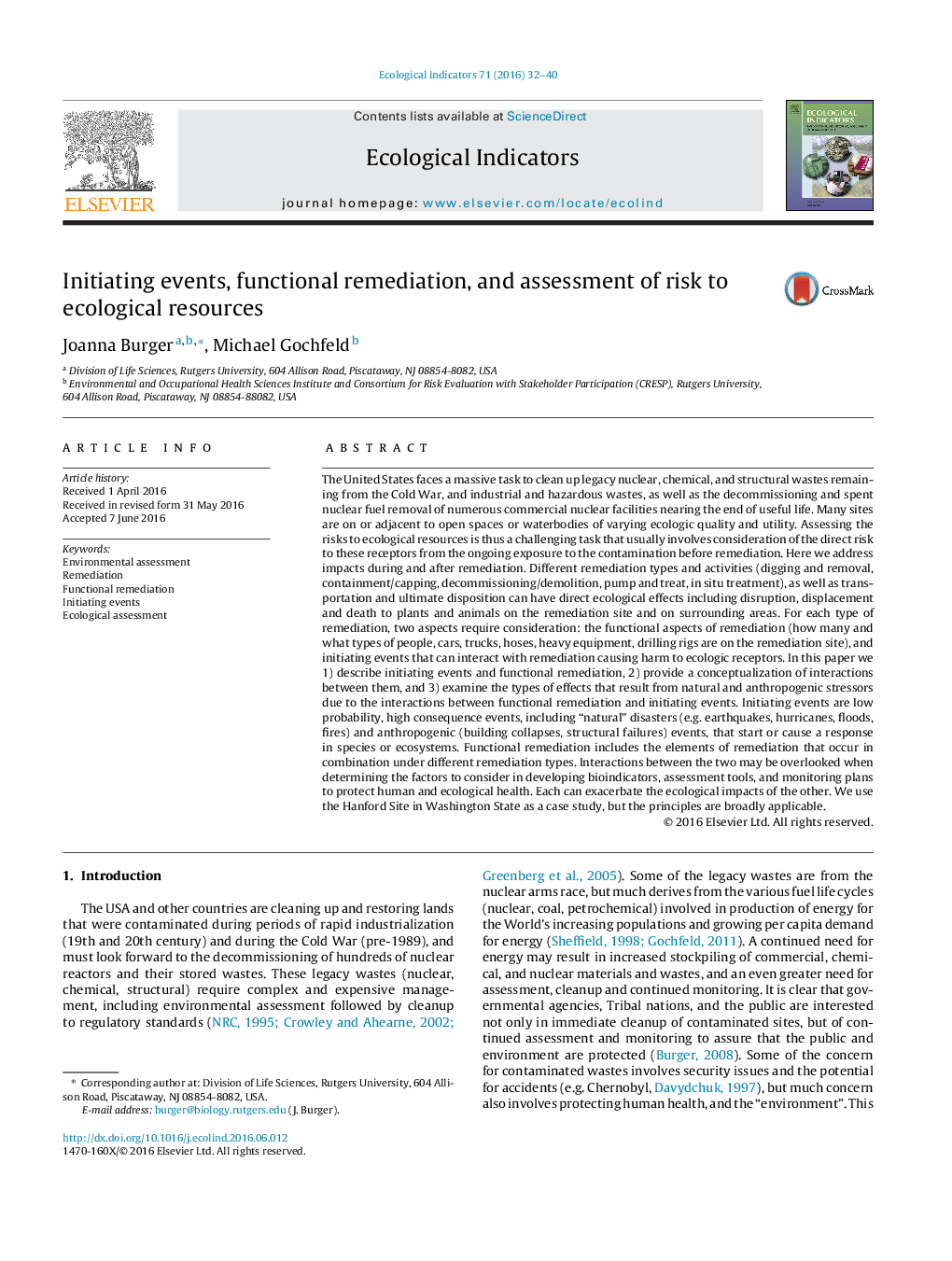| کد مقاله | کد نشریه | سال انتشار | مقاله انگلیسی | نسخه تمام متن |
|---|---|---|---|---|
| 6292900 | 1617131 | 2016 | 9 صفحه PDF | دانلود رایگان |
عنوان انگلیسی مقاله ISI
Initiating events, functional remediation, and assessment of risk to ecological resources
ترجمه فارسی عنوان
حوادث ابتدایی، اصلاح عملکرد و ارزیابی خطر برای منابع زیست محیطی
دانلود مقاله + سفارش ترجمه
دانلود مقاله ISI انگلیسی
رایگان برای ایرانیان
کلمات کلیدی
ارزیابی زیست محیطی، بهبود اصلاح عملکرد وقایع آغازین، ارزیابی زیست محیطی،
ترجمه چکیده
ایالات متحده با یک وظیفه عظیم برای پاکسازی زباله های هسته ای، شیمیایی و ساختاری که از جنگ سرد و مواد زائد صنعتی و خطرناک پاک شده است، و نیز حذف سوخت هسته ای از تاسیسات تجاری متعددی در نزدیکی پایان مفید زندگی بسیاری از سایت ها در فضاهای باز و یا آبجکت های مختلف کیفیت و اکولوژیکی متفاوت هستند. بنابراین ارزیابی خطرات منابع زیست محیطی، یک وظیفه چالش برانگیز است که معمولا شامل ریسک مستقیم این گیرنده ها از در معرض آلودگی فعلی قبل از اصلاح می شود. در اینجا ما در معرض اثرات در طول و پس از اصلاح. انواع و فعالیت های مختلف تصفیه (حفاری و برداشت، انسداد / محدود کردن، انهدام / تخریب، پمپ و درمان، درمان در محل)، و همچنین حمل و نقل و نهایی، می توانند اثرات زیست محیطی مستقیم، از جمله اختلال، جابجایی و مرگ را به گیاهان و حیوانات در سایت تصفیه و مناطق اطراف آن. برای هر نوع تصفیه، دو جنبه مورد نیاز است: جنبه های عملیاتی اصلاح (تعداد و نوع افراد، اتومبیل ها، کامیون ها، شیلنگ ها، تجهیزات سنگین، سکوهای حفاری در محل احیای) و شروع رویدادهایی که می توانند با آن ارتباط برقرار کنند اصلاح باعث آسیب رسیدن به گیرنده های اکولوژیک می شود. در این مقاله ما 1) رویدادهای آغازین و اصلاح عملکرد را توصیف می کنیم، 2) مفهوم سازی تعاملات بین آنها را ارائه می دهیم؛ 3) بررسی انواع اثرات ناشی از تنش های طبیعی و انسان شناختی به دلیل تعاملات بین اصلاح عملکرد و وقایع آغازین. رویدادهای ابتدایی عبارتند از: احتمال کم، وقایع بالا نتیجه، از جمله؟ بلایای طبیعی (مانند زمین لرزه ها، طوفان ها، سیل ها، آتش سوزی ها) و انسان شناسی (سقوط ساختمان، شکست های ساختاری) رویدادها، شروع یا ایجاد پاسخ در گونه ها و یا اکوسیستم ها. اصلاح عملکرد شامل عناصر اصلاح شده است که در ترکیب با انواع مختلف تصفیه رخ می دهد. تعاملات بین این دو در هنگام تعیین عواملی که باید در توسعه زیست شناسان، ابزارهای ارزیابی و برنامه های نظارت برای محافظت از سلامت انسان و محیط زیست مورد توجه قرار گیرد نادیده گرفته می شود. هر کدام می تواند اثرات زیست محیطی دیگر را تشدید کند. ما از یک سایت هانفورد در ایالت واشنگتن به عنوان نمونه مورد استفاده استفاده می کنیم، اما این اصول عموما قابل اجرا هستند.
موضوعات مرتبط
علوم زیستی و بیوفناوری
علوم کشاورزی و بیولوژیک
بوم شناسی، تکامل، رفتار و سامانه شناسی
چکیده انگلیسی
The United States faces a massive task to clean up legacy nuclear, chemical, and structural wastes remaining from the Cold War, and industrial and hazardous wastes, as well as the decommissioning and spent nuclear fuel removal of numerous commercial nuclear facilities nearing the end of useful life. Many sites are on or adjacent to open spaces or waterbodies of varying ecologic quality and utility. Assessing the risks to ecological resources is thus a challenging task that usually involves consideration of the direct risk to these receptors from the ongoing exposure to the contamination before remediation. Here we address impacts during and after remediation. Different remediation types and activities (digging and removal, containment/capping, decommissioning/demolition, pump and treat, in situ treatment), as well as transportation and ultimate disposition can have direct ecological effects including disruption, displacement and death to plants and animals on the remediation site and on surrounding areas. For each type of remediation, two aspects require consideration: the functional aspects of remediation (how many and what types of people, cars, trucks, hoses, heavy equipment, drilling rigs are on the remediation site), and initiating events that can interact with remediation causing harm to ecologic receptors. In this paper we 1) describe initiating events and functional remediation, 2) provide a conceptualization of interactions between them, and 3) examine the types of effects that result from natural and anthropogenic stressors due to the interactions between functional remediation and initiating events. Initiating events are low probability, high consequence events, including “natural” disasters (e.g. earthquakes, hurricanes, floods, fires) and anthropogenic (building collapses, structural failures) events, that start or cause a response in species or ecosystems. Functional remediation includes the elements of remediation that occur in combination under different remediation types. Interactions between the two may be overlooked when determining the factors to consider in developing bioindicators, assessment tools, and monitoring plans to protect human and ecological health. Each can exacerbate the ecological impacts of the other. We use the Hanford Site in Washington State as a case study, but the principles are broadly applicable.
ناشر
Database: Elsevier - ScienceDirect (ساینس دایرکت)
Journal: Ecological Indicators - Volume 71, December 2016, Pages 32-40
Journal: Ecological Indicators - Volume 71, December 2016, Pages 32-40
نویسندگان
Joanna Burger, Michael Gochfeld,
